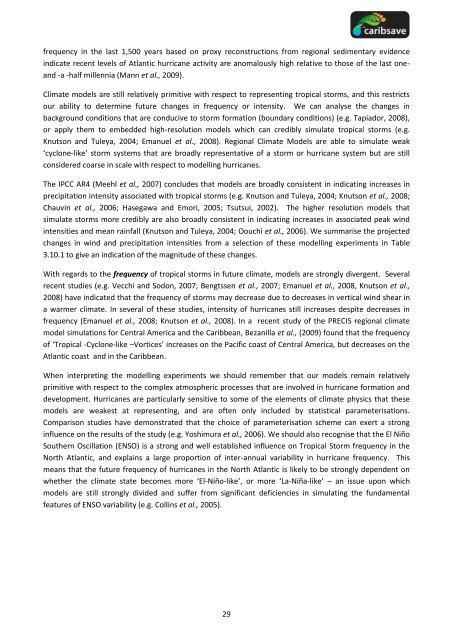Create successful ePaper yourself
Turn your PDF publications into a flip-book with our unique Google optimized e-Paper software.
frequency in the last 1,500 years based on proxy reconstructions from regional sedimentary evidence<br />
indicate recent levels of Atlantic hurricane activity are anomalously high relative to those of the last one-<br />
<strong>and</strong> -a -half millennia (Mann et al., 2009).<br />
Climate models are still relatively primitive with respect to representing tropical storms, <strong>and</strong> this restricts<br />
our ability to determine future changes in frequency or intensity. We can analyse the changes in<br />
background conditions that are conducive to storm formation (boundary conditions) (e.g. Tapiador, 2008),<br />
or apply them to embedded high-resolution models which can credibly simulate tropical storms (e.g.<br />
Knutson <strong>and</strong> Tuleya, 2004; Emanuel et al., 2008). Regional Climate Models are able to simulate weak<br />
‘cyclone-like’ storm systems that are broadly representative of a storm or hurricane system but are still<br />
considered coarse in scale with respect to modelling hurricanes.<br />
The IPCC AR4 (Meehl et al., 2007) concludes that models are broadly consistent in indicating increases in<br />
precipitation intensity associated with tropical storms (e.g. Knutson <strong>and</strong> Tuleya, 2004; Knutson et al., 2008;<br />
Chauvin et al., 2006; Hasegawa <strong>and</strong> Emori, 2005; Tsutsui, 2002). The higher resolution models that<br />
simulate storms more credibly are also broadly consistent in indicating increases in associated peak wind<br />
intensities <strong>and</strong> mean rainfall (Knutson <strong>and</strong> Tuleya, 2004; Oouchi et al., 2006). We summarise the projected<br />
changes in wind <strong>and</strong> precipitation intensities from a selection of these modelling experiments in Table<br />
3.10.1 to give an indication of the magnitude of these changes.<br />
With regards to the frequency of tropical storms in future climate, models are strongly divergent. Several<br />
recent studies (e.g. Vecchi <strong>and</strong> Sodon, 2007; Bengtssen et al., 2007; Emanuel et al., 2008, Knutson et al.,<br />
2008) have indicated that the frequency of storms may decrease due to decreases in vertical wind shear in<br />
a warmer climate. In several of these studies, intensity of hurricanes still increases despite decreases in<br />
frequency (Emanuel et al., 2008; Knutson et al., 2008). In a recent study of the PRECIS regional climate<br />
model simulations for Central America <strong>and</strong> the Caribbean, Bezanilla et al., (2009) found that the frequency<br />
of ‘Tropical -Cyclone-like –Vortices’ increases on the Pacific coast of Central America, but decreases on the<br />
Atlantic coast <strong>and</strong> in the Caribbean.<br />
When interpreting the modelling experiments we should remember that our models remain relatively<br />
primitive with respect to the complex atmospheric processes that are involved in hurricane formation <strong>and</strong><br />
development. Hurricanes are particularly sensitive to some of the elements of climate physics that these<br />
models are weakest at representing, <strong>and</strong> are often only included by statistical parameterisations.<br />
Comparison studies have demonstrated that the choice of parameterisation scheme can exert a strong<br />
influence on the results of the study (e.g. Yoshimura et al., 2006). We should also recognise that the El Niño<br />
Southern Oscillation (ENSO) is a strong <strong>and</strong> well established influence on Tropical Storm frequency in the<br />
North Atlantic, <strong>and</strong> explains a large proportion of inter-annual variability in hurricane frequency. This<br />
means that the future frequency of hurricanes in the North Atlantic is likely to be strongly dependent on<br />
whether the climate state becomes more ‘El-Niño-like’, or more ‘La-Niña-like’ – an issue upon which<br />
models are still strongly divided <strong>and</strong> suffer from significant deficiencies in simulating the fundamental<br />
features of ENSO variability (e.g. Collins et al., 2005).<br />
29





